Flying Drones in Iceland
As of March the 1st 2024, Iceland will finally adopt EASA’s regulations on flying drones. This is a good thing, as rules will be in line with Europe’s thus making it easier to understand the regulations all over the European continent.
However, in addition to EASA’s rules, there also are several additional rules one should be aware of, mostly regarding areas where you can or cannot fly, and where you need a special permit. This mostly involves National parks and protected areas, as we’ll see later.
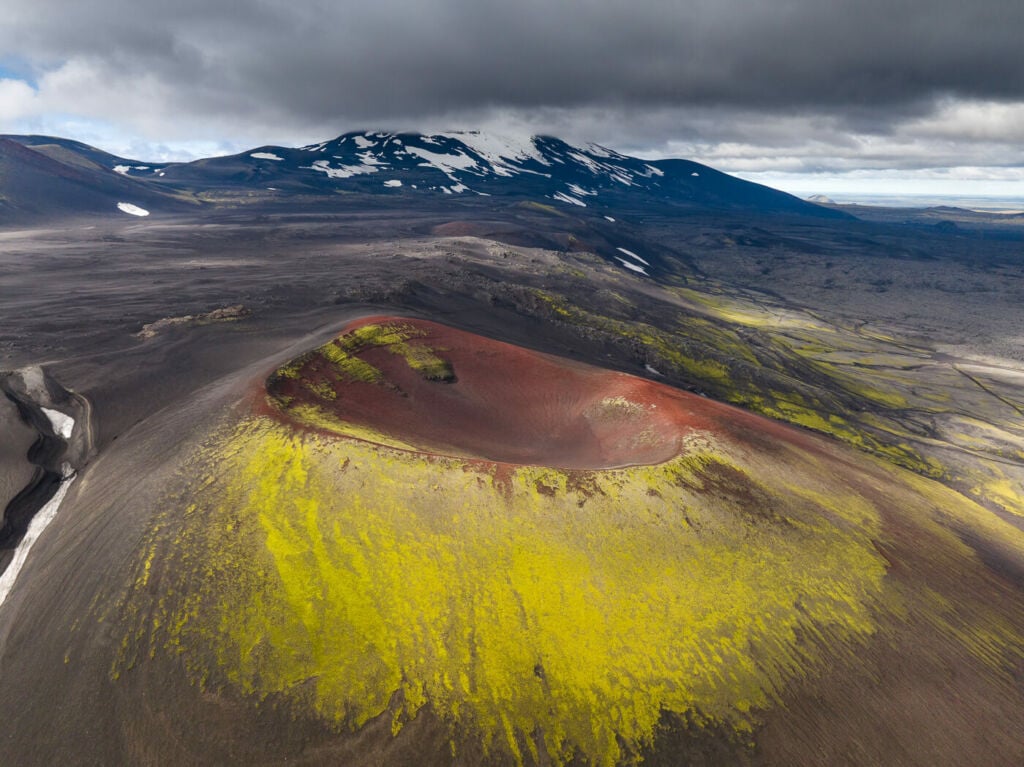
The Apple Crater, or Rauðaskál, with Hekla in the Background.
It’s not a secret Iceland is one of the most beautiful countries to fly drones in for aerial photography. That is the main reason why so many bring their drones there.
And, of course, this needs to be done in full compliance with all the EU and local regulations. In this post, I’ll describe all the main rules and reference all the sources, so that you can get all the information you need to fly safely and in respect of local laws and regulations.
Table of contents
- Inhaltsverzeichnis
- Drohnengesetze und -regeln in Island
- Flying a Drone in the Open Category in Iceland
- Flying Drones in Iceland for leisure
- Flying Drones in Iceland for commercial purposes
- National parks and protected areas and Drone Permits in Iceland
- Flying drones during a Volcanic eruption in Iceland
- Tips to safely flying drones in Iceland
- Flying Drones in Iceland – Conclusion
- Additional Resources
Drone Laws and Rules In Iceland
First off, let’s take a look at EASA’s rules. Note these rules apply to all the EU countries and this means if you are registered as a drone operator in a EU country, the registration is also valid in all the other countries within the EU.
- All drone operators must register unless they are only flying drones under 250g with no camera. If a drone weighs less than 250g but has a camera, you need to register.
- Operators flying drones weighing more than 250g must complete a training course and pass a test, to obtain a certificate that is recognized through the EU. This usually costs a small fee, in the range of 40 to 60 EUR.
This means that if you are planning on flying drones for photography, you need at least to register. If your drone also weighs more than 250g, you need to take the course and the test too. You can do both of these on flydrone.is.
In addition to that, several other regulations apply to each category of drone.
First of all, there are two main categories drones fall into. The Open and Specific categories. I will not get into the details of specific categories as they apply to drones weighing more than 25KG and are outside the scope of this blog. You can find all the information you need on the Specific category here.
So, pretty much all the consumer drones for aerial photography will fall into the open category, which is for drones weighing less than 25 KG.

Sigöldugljúfur, or the valley of tears.
Flying a Drone in the Open Category in Iceland
The ‘open’ category can be divided into three sub-categories – A1, A2, and A3, each summarized as:
- A1: Permitted to fly over individuals but not over gatherings of people.
- A2: Allows flying close to people.
- A3: Requires maintaining a significant distance from people.
With the new drone regulations, drones sold after January the 1st 2024 need to have a C label – from C0 to C4. Essentially, C0/C1 fall in the A1 category, C2 in the A2 category, and C3/C4 in the A3 category. This sorts of add to the complexity of the regulation, but you can find a very easy-to-read table on the EASA’s website. Here is a quick overview of the main categories:
- If you’re using a lightweight drone under 250 grams, like the DJI Mini 3 Pro or DJI Mini 4 Pro with the C0 label, you don’t need any extra licenses.
- For drones weighing more than 250 grams, you need to take the A1/A3 exam. Once you pass, you can operate drones up to 900 grams in subcategory A1 and up to 25 kg in subcategory A3. Look for the C1, C2, or C3 labels on these drones.
- Subcategory A2 allows closer proximity to people and is considered the riskiest in the Open category. Pilots in A2 must meet additional competency requirements and pass an extra A2 exam.
All legacy drones, which means drones without a C label, can still be operated in either Category A1 or A3, depending on their weight.
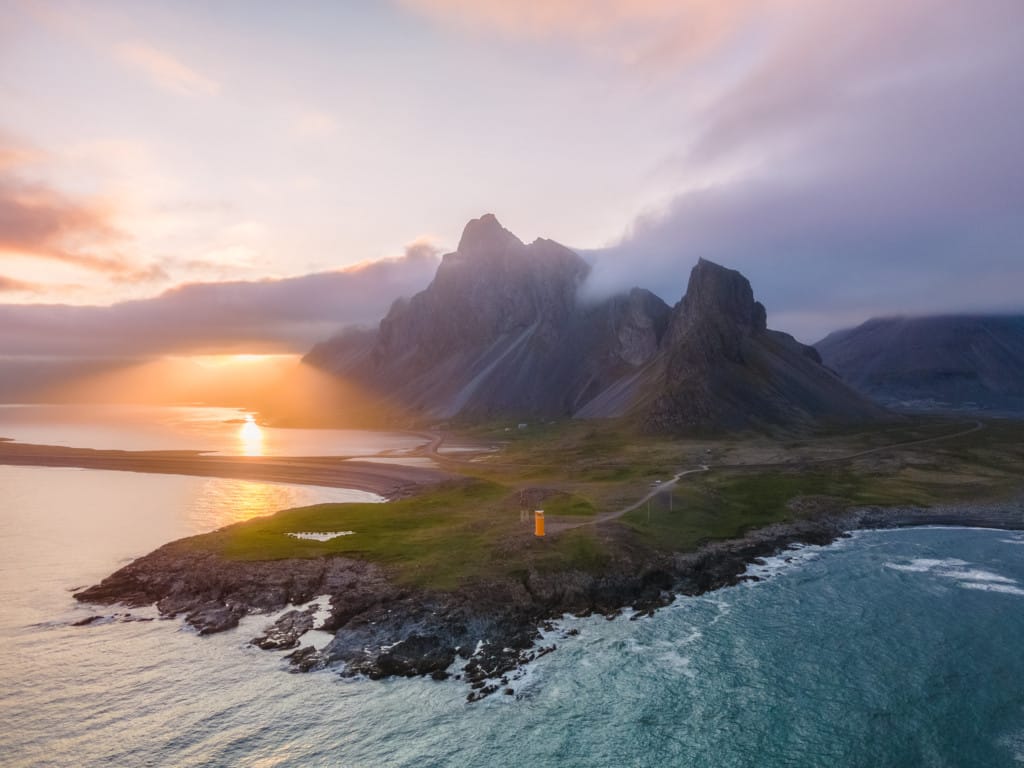
The last rays of Sun shine behind Eystrahorn, Iceland. Blend of 5 images taken with a Mavic Air 2.
Flying Drones in Iceland for leisure
This applies if you are flying your drone to take photos for yourself or post them on social media.
- Label your drone with your name, address, and phone number.
- You can fly the drone up to 120m from the ground (not the original take-off point).
- Do not fly beyond your visual line of sight (VLOS)
- Avoid flying over crowds
- Always keep direct visual contact with your drone.
- You’re responsible for any damages caused by your drone during flight.
- In urban areas, drones must weigh 7 kg or less; in rural areas, the limit is 25 kg.
- Drones weighing 20 kg or more require insurance.
- Limit altitude to 120 meters (394 feet) above ground or sea.
- Avoid flying over crowds, and people, or within 2 km (1.24 miles) of international airports.
- Stay 1.5 km (0.93 miles) away from other airports.
- In urban areas, maintain a 50-meter (164 feet) distance from buildings; in rural areas, keep 150 meters (492 feet) away.
Flying Drones in Iceland for commercial purposes
There also are specific rules if you need to fly your drone for commercial purposes. That is technically anything that involves selling or licensing photos too. In addition to having to label your drone and keep it within the VLOS:
- In cities, use drones weighing 3 kg (6.61 pounds) or less; in rural areas, stay under 25 kg (55 pounds).
- Drones weighing 20 kg (44 pounds) or more need insurance.
- Keep the drone below 120 meters (394 feet) above ground or sea.
- Avoid flying over crowds, and people, or within 2 km (1.24 miles) of international airports.
- Stay at least 1.5 km (0.93 miles) away from other airports.
- In cities, steer clear of buildings within 50 meters (164 feet); in rural areas, maintain a 150-meter (492 feet) distance.
- Don’t fly within 150 meters (492 feet) of public buildings.
- Check and follow local drone and privacy rules.
- Ensure your drone flights don’t disrupt air traffic.
- Avoid flying over vehicles or ship traffic.
- You’re responsible for any damages caused by your drone during flight.
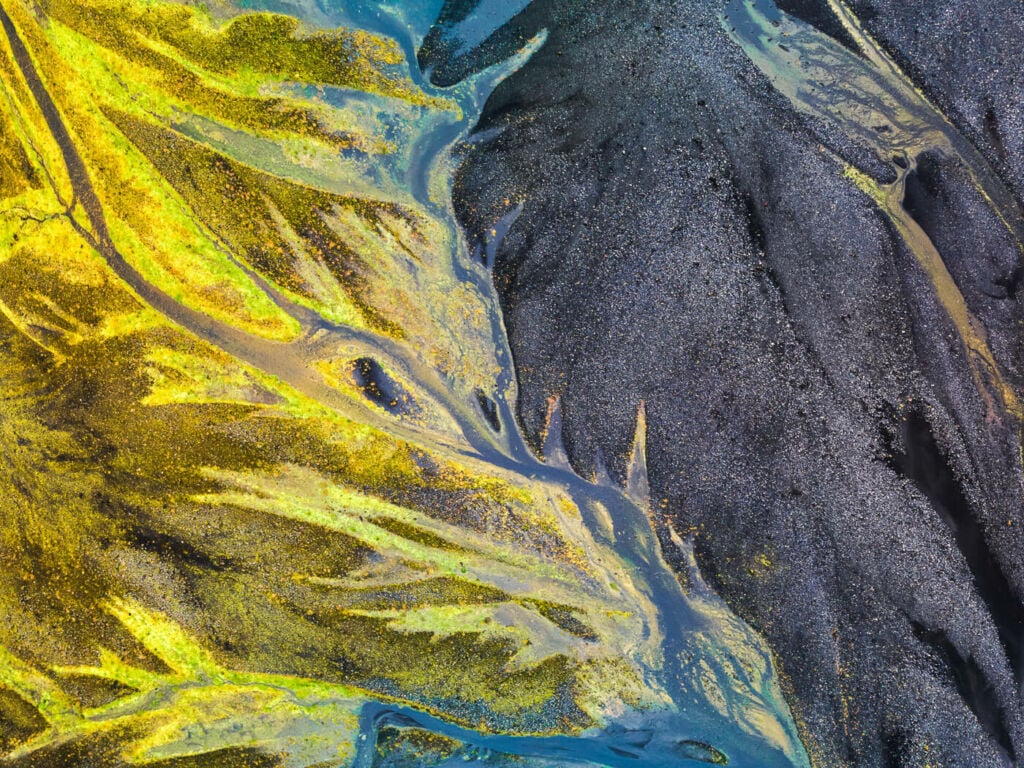
Drone shot of a river in the Mýrdalssandur outwash plains. Mavic Air 2.
National parks and protected areas and Drone Permits in Iceland
The first thing to be aware of is that drones are only allowed in National Parks and protected areas with a permit. However, many places, such as Landamannalaugar, Kerlingafjoll, Vatnajokull, and so on, require a permit for which it’s possible to apply online.
At the time of writing, applying for a permit costs 41.600 ISK for up to two areas, and 83.200 IKS for three or more (source – September 2024). You can apply for a permit here.
However, the Þingvellir, Vatnajökull, and Snæfellsjökull national parks will issue their permits, and they need to be contacted directly:
Vatnajökull National ParkEdit: As of the 11th of July 2024, the Vatnajokull National Park updated the rules and does not require special permissions. More info here.- Þingvellir National Park
- Snæfellsjökull National Park
Additionally, here you can find:
Flying drones during a Volcanic eruption in Iceland
Let’s take a moment to talk about drones during a volcanic eruption. This is one of those events where a drone can allow you to capture shots that would otherwise be impossible.
I have seen all the first three Volcanic eruptions on the Reykjanes peninsula and flying a drone there was an amazing experience. Not only for the photography part of it but also just to be able to watch the babbling lava inside the erupting vents.
However, in the last few eruptions, some flying bans were implemented.
If you find yourself in Iceland during an eruption and intend to fly a drone, make sure to check whether you can do it first. Check the Icelandic Transport Website, Safetravels.is and Visitreykjanes, as they usually post such notices too.
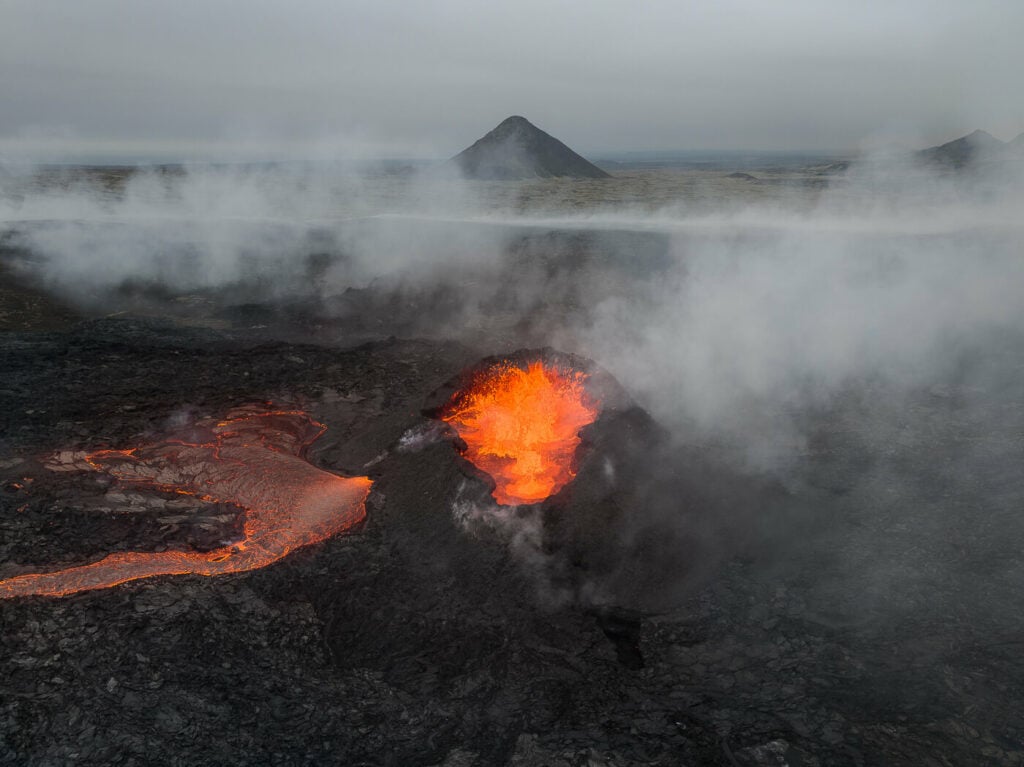
The 2023 Litli-Hrútur Eruption
Tips to safely flying drones in Iceland
This is a list of personal tips and rules I follow when flying a drone in Iceland.
- Do not rely on the DJI app to understand if you can fly in an area or not: all the national parks and protected areas are marked by DJI as “recommended” zones, even if it is not allowed to fly there.
- Avoid the crowded hours; you’d be freer to fly around and less concerned about disturbing others.
- Find an isolated corner to fly and get it up high as soon as possible to avoid disturbing other tourists. Drones can fly, so there is no need to take off close to other people. Also, always assume other people are having the time of their life! It would not be nice to disturb them with the annoying buzz of a drone, would it?
- Be mindful of wildlife: Drones are very stressful for them, especially for birds. They may even try to attack your drone. If this happens to you, fly low and land the drone as soon as possible, even if it is an area where you can fly.
Flying Drones in Iceland – Conclusion
So, should you bring your drone to Iceland, despite all the restrictions, regulations, and no-fly zones? Yes, but only with due caution and respect for local laws, wildlife, and other visitor’s experience.
Here’s a bit of a fun fact. During the 2022 Fagradalsfjall eruption, I met several other tourists who did not bring their drones because of all the restrictions in Iceland. I felt for them as they missed the opportunity to shoot the erupting Volcano with a drone, a once-in-a-lifetime opportunity. You may not want to be that person, but you also don’t want the one bothering other people and flying in restricted areas without a permit.
Plenty of areas outside the main tourist hotspots are excellent for aerial photography in Iceland. So go ahead and discover them! You will come back with fresh, amazing shots from new locations few have already seen.
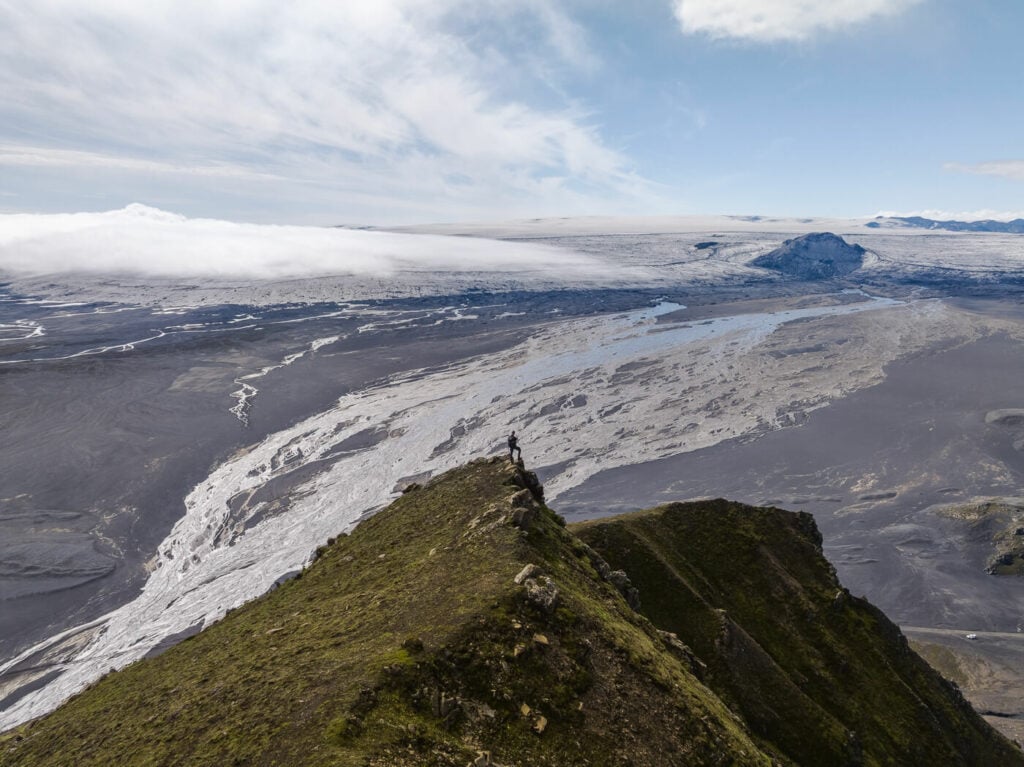
Hiker on top of Mælifell
Additional Resources
- If you are interested in knowing more about flying drones in each EU country, be sure to check out this EASA’s list of regulations by country.
- Discover the best hiking and photography locations in Iceland here.
- Check my recommendations on drones for Hikers.
Car or Camper Van Rentals
I can definitely recommend two companies here:
- Cars: Blue Car Rental, (5% discount through The Photo Hikes) which is the largest Car rental company in Iceland, and for good reasons. Free Cancellation, Unlimited mileage, 24-hour breakdown assistance, SCDW, CDW, TP, and GP insurance are included in the price. Blue Car Rental is also located within walking distance of the Keflavik Airport, so you can be on your way to explore Iceland right away. I’ve always been happy with my rentals there, which is why I’m happy to recommend their services here on my blog.
- Camper Vans: CampEasy. With CampEasy, you can rent 2WD or 4×4 campers alike. With a raised Chassis, larger tires, and extra insurance with reduced liability for river crossing, their 4X4 campers are the best choice for your trip into the Highlands. Their Website also provides extensive information about roads you can take and instructions on river crossings. Perfect choice for a hiking holiday in the highlands!
These are my two favorite companies in each respective rental area reason. For this reason, I am happy to recommend both on my blog. If you also like this blog, booking through them is a great way to support it. I’ll get a small commission fee at no additional cost, so you can essentially support the running costs of this blog for free too.
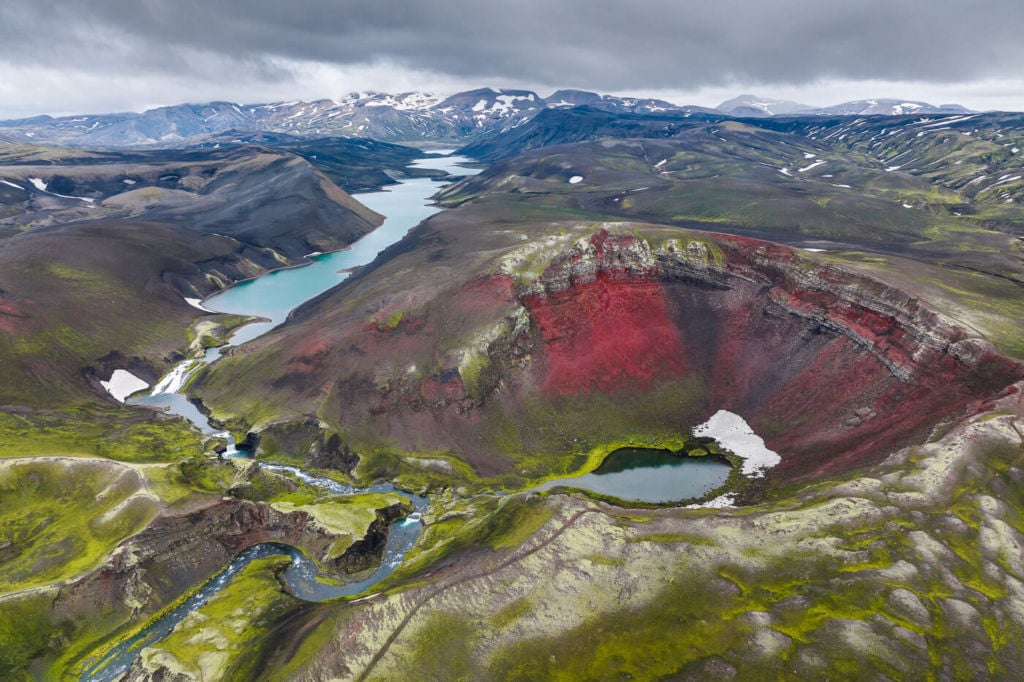
Leave A Comment